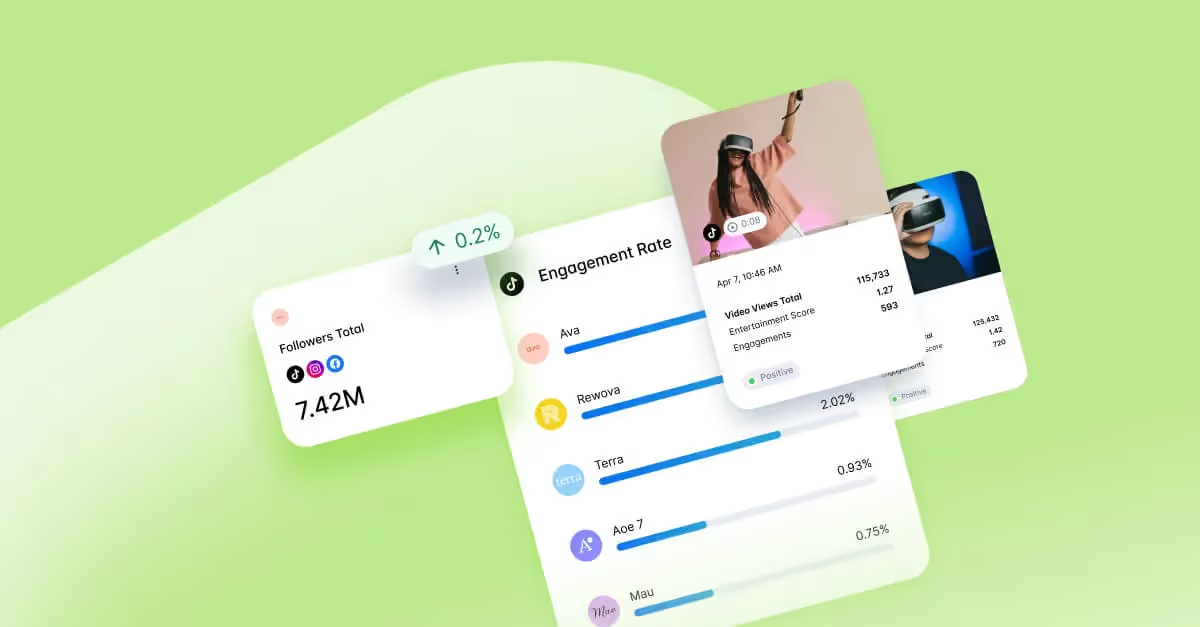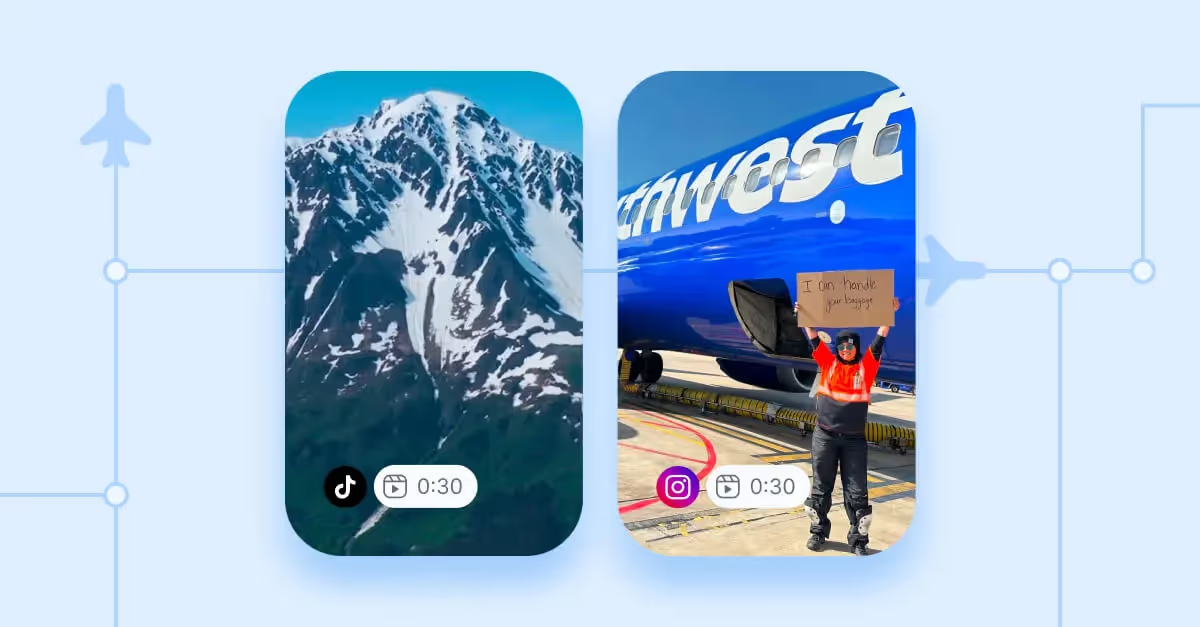Your Guide To Social Selling in 2026
Sell smarter with storytelling, creators, and community to drive conversions.

Dropping links and hoping for clicks isn’t enough anymore: it’s time to usher in the era of social selling, where brands slide into feeds, and even DMs, but not with pushy sales pitches; they lead with sparking authentic conversations and developing relationships that feel more friendly than sales-forward.
Social selling is the modern version of word-of-mouth. Instead of waiting for customers to stumble into your store, you show up where they already are: scrolling on Instagram, watching TikTok, or joining conversations on LinkedIn. Today’s consumers aren’t just shopping, they’re connecting. They want to know a brand’s story, vibe, and what makes you unique from everyone else in their feed.
In fact, the brands that master social selling are the ones who spark genuine conversations, grow loyal communities, and turn followers into lifelong customers. When done right, social selling builds communities, creates loyalty, and turns everyday interactions into real social media ROI.
TL;DR:
- Social selling replaces cold calls and pushy ads with authentic conversations that build trust first and sell second.
- Inbound social selling works best: focus on connecting and creating value instead of chasing leads with hard pitches.
- Benefits include shorter sales cycles, stronger long-term customer relationships, and measurable paths to purchase.
- Best practices center on leading with value, tapping into creators and UGC, using platform-native shopping tools, and engaging authentically.
- Success comes from tracking meaningful metrics like conversions and customer loyalty, not vanity numbers such as likes or follows.
What Is Social Selling?
Thinking about a transition from cold calls and stiff email chains? Well, it’s time to introduce social selling. At its core, social selling is when brands use social media to connect with their audience (a.k.a. potential customers), engage in authentic conversations, and share promotional information that makes their audience tap that ‘Add to Cart’ button.
Social selling is not about pushing products in people’s faces 24/7. It’s about building trust first, and selling second. Consumers trust influencers, reviews, and peer recommendations more than ads, with creators receiving 6 times the engagement that brand posts receive on social media. Social selling is your brand’s backstage pass to staying relevant.
For example, let’s say you post a behind-the-scenes video of how your product is made, and someone comments, “Omg I NEED this!”. Instead of hitting them with a robotic sales pitch or a link, you respond with a genuine thank you or funny joke. Maybe you go the extra mile and respond with a discount code, and suddenly, you turn a casual scroll into a loyal customer. That’s social selling in action.
Traditional vs. Inbound Social Selling
With traditional social selling, you’re saying “Here’s why you should buy this”. This is the cold-call era, all about blasting messages, pitching hard, and hoping someone bites. Brands would go wide instead of deep, posting a lot of ads filled with value propositions, sending unsolicited emails, and pushing for the close without first building a real connection. Sure, it gets attention, and while there’s always time and place for a classic, well-placed and well-targeted social media advertisement, this overt selling doesn’t always garner the right kind of attention (we all know the feeling of dodging that random sales pitch in our DMs).
With inbound social selling, you’re saying “Here’s how we can solve your problem”. This is the glow-up for social selling we’ve all been waiting for. Instead of chasing leads, inbound flips the script: it’s about creating value, sparking genuine conversations, and letting trust do the heavy lifting. You’re not interrupting your audience with numerous sales pitches; you’re attracting them with content that actually meets a need, inspires them, or that they deeply relate to. Think thought-leadership posts on LinkedIn, TikToks that answer FAQs in a fun way, or Instagram Stories that give behind-the-scenes peeks into your brand.
Ultimately, you can think of traditional social selling with the classic adage ‘ABC: always be closing’ and inbound social selling as ‘ABC: always be connecting’.
Why Is Social Selling Important?
People aren’t typically scrolling through Instagram or TikTok thinking, “Wow, I really hope I see an ad today.” People are looking for entertainment, connections, and story telling. That’s where social selling comes in. Instead of shouting “buy this now!” into the void, you’re generating talk, answering questions in the comments, hopping on trends in a way that makes sense for your brand, and creating content that actually feels human. When customers trust you, they’re buying into your brand as much as they’re buying your products.
Consumers today are more skeptical than ever. A brand that builds authentic connections in their DMs, Stories, or even Lives, can mean long-term engagement and support. The more you show up as a brand that just “gets it”, the more people will want to stick around (and shop). You’re effectively not just making one sale, but you’re ensuring your buyers stick with you.
Benefits of Social Selling
We’ve established that social selling isn’t just a buzzword; it’s basically the new handshake for digital marketers. But what’s in it for brands, really? Let’s break down why sliding into social selling can enhance your social media marketing strategy:
Shortens Sale Cycle
No one likes waiting around forever, especially not your customers. With social selling, you skip the endless back-and-forth of cold calls and emails. Instead, you’re meeting people where they already hang out and giving them the content, answers, and value they need to hit “add to cart” faster. It’s like taking the express lane at the grocery store but for sales.
Build Long-term Trust
We’ve said it once, but it bears repeating: social selling isn’t about pushing products; it’s about building relationships. By consistently showing up with authentic content, answering questions, and actively listening to your audience, you plant seeds of trust. Trust is what turns casual scrollers into loyal buyers and even brand evangelists who stick with your brand long after the trend fades.
Offers Trackable Pathways To Purchase
Here’s the best part: social selling isn’t a shot in the dark. Thanks to analytics tools, UTM links, and platform insights like sentiment analysis, you can literally track how your conversations, posts, or DMs make your audience feel and how they lead to conversions. By connecting the dots between your content, the buying journey, and where you ultimately earn leads, you can hone the buying funnel over time and craft more of the content that resonates deeply with your audience.
Social Selling Best Practices
By now, you know that social selling is an essential move, but how do you strike the balance between organic promotion and authentic relationships? Don’t worry, we’ve got you. Here are tips on how to make natural social selling happen:
1. Lead With Value, Not the Pitch
Nobody logs onto TikTok or Instagram hoping to see another ad in their face. Instead, give your audience value first. That could mean sharing styling tips if you’re a fashion brand, a behind-the-scenes look at how your products are made, or even just being funny, relatable, and letting your brand’s personality shine through. When you show up for them first, they’ll be more likely to show up for you at checkout.
2. Use Platform-Native Shopping Features
Social platforms are literally begging you to sell smarter. Instagram Shops, TikTok Shop, and Pinterest Product Pins are all features that exist to make the shopping journey seamless. The less your followers have to leave the app, the less friction they’ll experience on their way to checkout.
3. Tap Into Creators and Community
People trust people far more than they trust logos. Collaborating with creators and micro-influencers helps you extend your reach and borrow their credibility. Even better? UGC creators are social proof gold as it shows real humans actually love your product.
4. Engage Authentically
Don’t post and ghost. Reply to comments, join conversations, and (respectfully) slide into DMs. When you’re authentic and consistent, your audience feels seen, and that’s how trust is built.
5. Track the Right Metrics
Vanity metrics like likes and views alone are interesting, but they don’t tell the whole story. Keep an eye on conversion metrics like Entertainment Score, engagement rate, clicks, saves, and actual sales generated from your social posts. Tracking the right numbers will help you understand what works and where you need to adjust your tactics.
Social Selling Examples
Now that we’ve covered what social selling is and why it’s a total game-changer, let’s see it in action. Some of the smartest and savviest top brands on social have already mastered the art of selling without “selling”. From celebrity-founded beauty brands that mix pop culture with shoppable posts to lifestyle brands serving up authentic UGC and community-driven content, these examples prove that blending strategy with authenticity is a match made in heaven.
White Fox
When it comes to social selling, White Fox is absolutely winning the game. This fashion-forward brand doesn’t just post pretty outfits on Instagram or TikTok, they make it ridiculously easy for fans to go from scrolling to checkout in just a few taps. How? By seamlessly weaving creators into their social commerce strategy.
Instead of stiff, traditional ads, White Fox leans into influencer-driven content that feels authentic and relatable, like your bestie showing you her latest haul. The magic move? They make those posts shoppable. That means no endless link-hunting or abandoned carts: just instant, friction-free conversions, right there on the app.
This approach does two big things:
- It keeps the shopping experience native to social (where their audience already spends hours scrolling).
- It builds trust through creators, because fans are way more likely to buy when they see their fave influencer rocking the look.
The result? White Fox is turning double-taps and “where is that from?” comments into real sales.
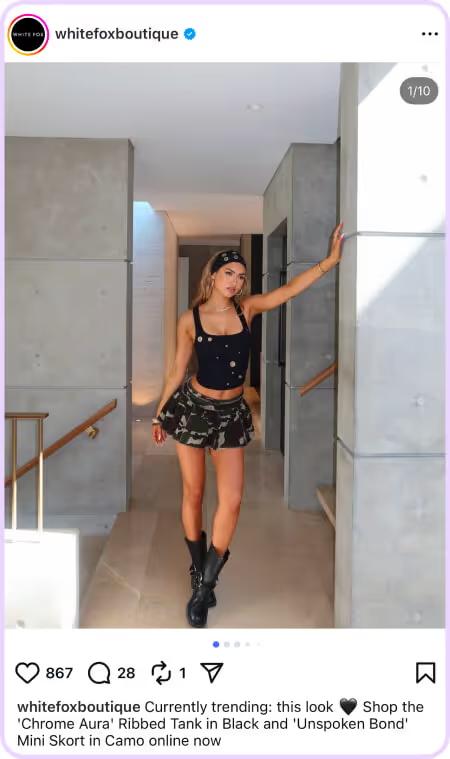
Liquid Death
If you think selling water can’t be cool, think again. Liquid Death took something as basic as H2O and turned it into a cultural movement. Instead of pumping dollars into boring traditional ads, they’ve leaned all the way into culture, community, and a killer brand vibe that feels more like a punk rock show than a beverage company.
Their strategy? Forget blending in on the shelf, Liquid Death builds loyalty by sparking conversations online, creating outrageous content (think viral skits and edgy campaigns), strategic influencer gifting, and positioning their water tallboys as a lifestyle. By prioritizing culture and community over traditional channels, their audience views their product as merch as much as water.
The takeaway for brands: Social selling isn’t about hard pitches, it’s about creating an image and identity that people want to be part of. Liquid Death nailed it by building trust and hype through targeted gifting (think podcasts where their logo will be seen by thousands), a unique design, and authentic (and often hilarious) connections that make customers feel like the brand represents them.
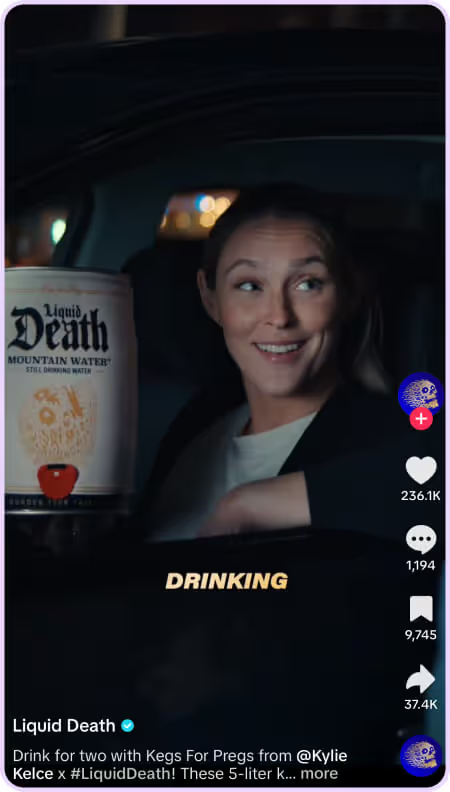
R.E.M. Beauty
When Ariana Grande launched R.E.M. Beauty, fans got access to her beauty favorites. This is exactly where social selling’s power kicks in.
If you’ve ever watched Ariana Grande apply eyeliner, her beauty venture likely comes as no surprise. With an already successful perfume line under her belt and millions of fans invested in her beauty routine, R.E.M. Beauty is the perfect vehicle for social selling. Celebrity-founded brands already come with built-in influence and trust, but R.E.M. Beauty takes it a step further by keeping its social presence authentic, creative, and shoppable.
Think behind-the-scenes content straight from the glam room, UGC that showcases real fans rocking the products, and pop-culture-tied launches that keep the brand trending, like their Wicked-inspired collection that had both Broadway stans and makeup lovers rushing to fill their online carts.
R.E.M. doesn’t just rely on hype. They’ve woven in social-first shopping tools like LikeShop, making it ridiculously easy for fans to scroll, tap, and shop instantly. This combo of trust (thanks to Ariana) and seamless buying options proves that social selling works with the right inspirations, collaborations, and giving your community exactly what they want.
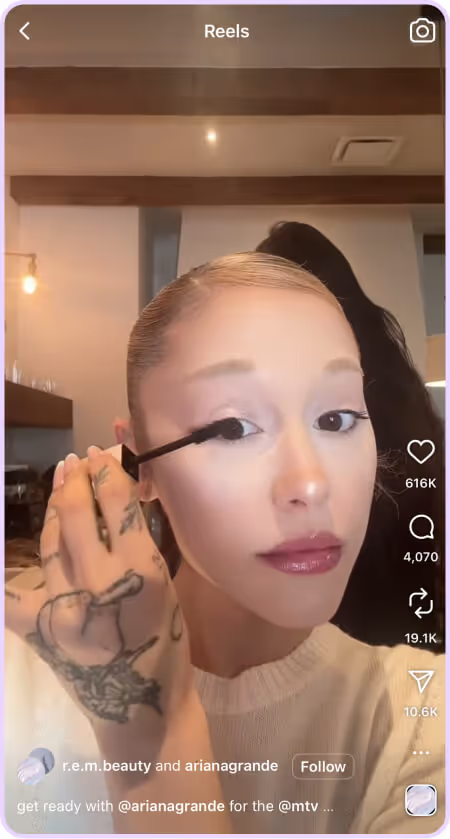
How To Measure Social Selling Success
As we mentioned previously, likes and views are nice, but don’t necessarily translate to higher cart value. With a solid social selling strategy, revenue comes from using social to build trust, authentic two-way conversations, and nurturing existing customer relationships. Think of it as modern sales with fewer cold calls, more real DMs, and TikToks that convert.
Social selling isn’t about posting that one viral Reel and hoping sales flood in. Brands need to measure success the right way, because if you’re not tracking, you’re just guessing. And no one wants a “wing-it” sales strategy in 2026.
So how do you do it? Start by setting realistic goals, whether that’s boosting conversions, lowering your cart abandonment rate, or increasing average basket size. Next, focus on metrics that directly connect to these goals. Instead of obsessing over vanity numbers like follower count, pay attention to engagement-to-purchase rates, repeat customer behavior, and even how quickly people move through your sales funnel.
Remember to be flexible. Social media trends move faster than a TikTok dance challenge, so knowing when to pivot based on insights is key. If one type of content isn’t driving clicks or your audience is bouncing at checkout, adjust your strategy, test something new, measure, and keep it moving.
At the end of the day, social selling is about building long-term trust and relationships, focusing on the right goals, and keeping your strategy sharp enough to actually deliver results.
Social Selling FAQs
What is the social selling index?
The Social Selling Index, or SSI, is basically your social media report card. SSI measures how effective you are at building your professional brand, finding the right people, engaging with insights, and building strong relationships on social platforms like LinkedIn.
Think of it as your “trustworthiness and influence score” for social selling: the higher your SSI, the more likely you are to spark conversations, create authentic connections, and drive real results for your brand.
What are the four pillars of social selling?
The four pillars of social selling are:
- Establish your brand: Show up consistently, craft your voice, and make sure your profile and content tell your story. Authenticity wins here.
- Find the right people: Don’t waste energy chasing everyone. Use social tools to connect with audiences that actually care about your brand.
- Engage with insights: Comment, share, and interact with valuable content. Conversations over cold pitches always win.
- Build strong relationships: The secret sauce: turning connections into trust. Once people trust you, sales follow naturally.





